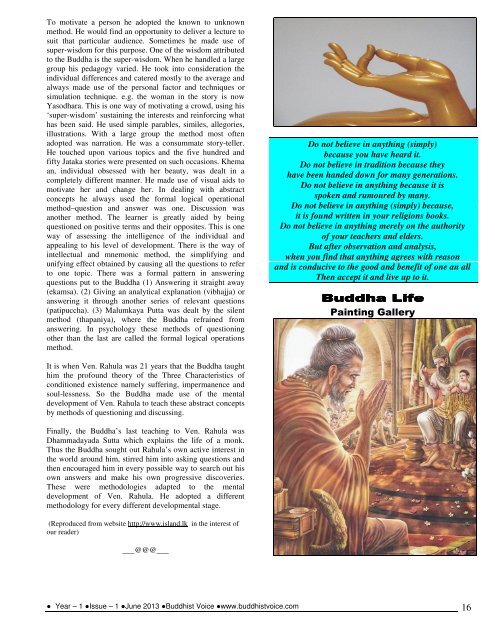BV - June 2013 Yr 1 Issue 1
You also want an ePaper? Increase the reach of your titles
YUMPU automatically turns print PDFs into web optimized ePapers that Google loves.
To motivate a person he adopted the known to unknown<br />
method. He would find an opportunity to deliver a lecture to<br />
suit that particular audience. Sometimes he made use of<br />
super-wisdom for this purpose. One of the wisdom attributed<br />
to the Buddha is the super-wisdom. When he handled a large<br />
group his pedagogy varied. He took into consideration the<br />
individual differences and catered mostly to the average and<br />
always made use of the personal factor and techniques or<br />
simulation technique. e.g. the woman in the story is now<br />
Yasodhara. This is one way of motivating a crowd, using his<br />
‘super-wisdom’ sustaining the interests and reinforcing what<br />
has been said. He used simple parables, similes, allegories,<br />
illustrations. With a large group the method most often<br />
adopted was narration. He was a consummate story-teller.<br />
He touched upon various topics and the five hundred and<br />
fifty Jataka stories were presented on such occasions. Khema<br />
an, individual obsessed with her beauty, was dealt in a<br />
completely different manner. He made use of visual aids to<br />
motivate her and change her. In dealing with abstract<br />
concepts he always used the formal logical operational<br />
method–question and answer was one. Discussion was<br />
another method. The learner is greatly aided by being<br />
questioned on positive terms and their opposites. This is one<br />
way of assessing the intelligence of the individual and<br />
appealing to his level of development. There is the way of<br />
intellectual and mnemonic method, the simplifying and<br />
unifying effect obtained by causing all the questions to refer<br />
to one topic. There was a formal pattern in answering<br />
questions put to the Buddha (1) Answering it straight away<br />
(ekamsa). (2) Giving an analytical explanation (vibhajja) or<br />
answering it through another series of relevant questions<br />
(patipuccha). (3) Malumkaya Putta was dealt by the silent<br />
method (thapaniya), where the Buddha refrained from<br />
answering. In psychology these methods of questioning<br />
other than the last are called the formal logical operations<br />
method.<br />
Do not believe in anything (simply)<br />
because you have heard it.<br />
Do not believe in tradition because they<br />
have been handed down for many generations.<br />
Do not believe in anything because it is<br />
spoken and rumoured by many.<br />
Do not believe in anything (simply) because,<br />
it is found written in your religions books.<br />
Do not believe in anything merely on the authority<br />
of your teachers and elders.<br />
But after observation and analysis,<br />
when you find that anything agrees with reason<br />
and is conducive to the good and benefit of one an all<br />
Then accept it and live up to it.<br />
Buddha Life<br />
Painting Gallery<br />
It is when Ven. Rahula was 21 years that the Buddha taught<br />
him the profound theory of the Three Characteristics of<br />
conditioned existence namely suffering, impermanence and<br />
soul-lessness. So the Buddha made use of the mental<br />
development of Ven. Rahula to teach these abstract concepts<br />
by methods of questioning and discussing.<br />
Finally, the Buddha’s last teaching to Ven. Rahula was<br />
Dhammadayada Sutta which explains the life of a monk.<br />
Thus the Buddha sought out Rahula’s own active interest in<br />
the world around him, stirred him into asking questions and<br />
then encouraged him in every possible way to search out his<br />
own answers and make his own progressive discoveries.<br />
These were methodologies adapted to the mental<br />
development of Ven. Rahula. He adopted a different<br />
methodology for every different developmental stage.<br />
(Reproduced from website http://www.island.lk in the interest of<br />
our reader)<br />
___@@@___<br />
● Year – 1 ●<strong>Issue</strong> – 1 ●<strong>June</strong> <strong>2013</strong> ●Buddhist Voice ●www.buddhistvoice.com 16



